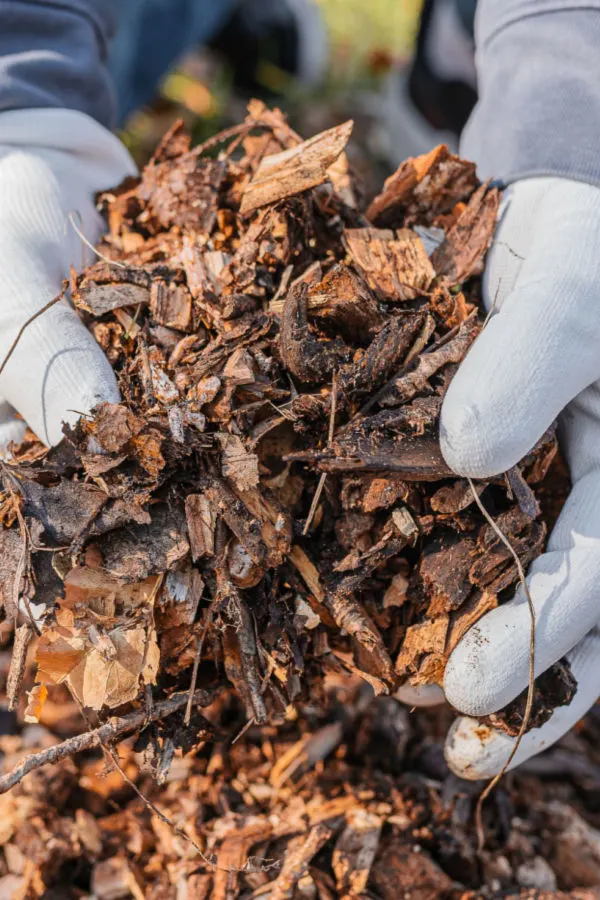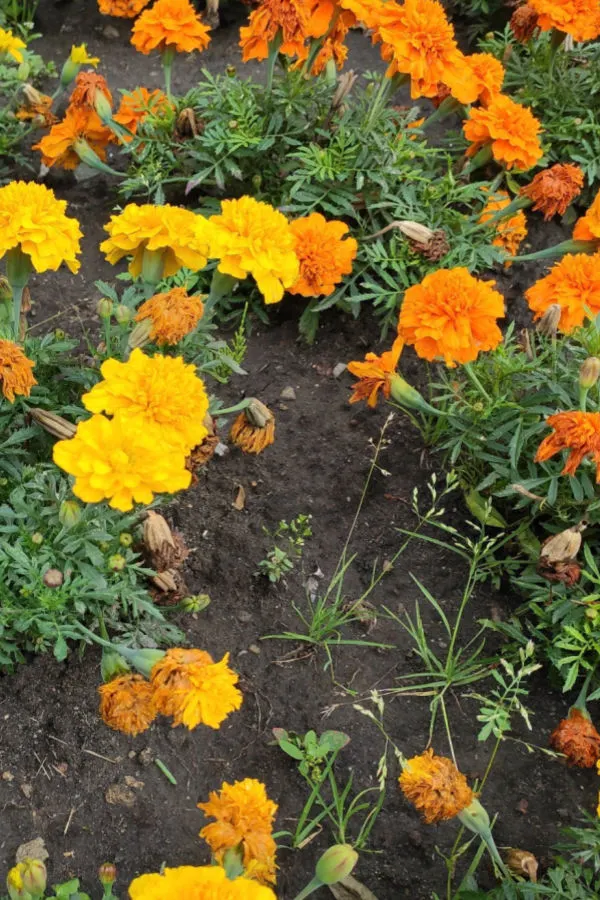As crazy as it sounds, putting mulch down in your flowerbeds in the fall is actually more important than mulching your plants in the spring and early summer. Not so much for the looks, but for all the benefits it can bring for next year!
Mulching flowerbeds before winter might seem a bit out of the ordinary. Although many homeowners are more than happy to spruce up their beds in the spring, few seldom think about applying a second layer late in the growing season.
Many might think of fall mulching as a waste of time and money with winter just around the corner. After all, mulch can be expensive. And is it really important to make your flowerbeds fresh and pretty at the same time most of your perennials and bushes are dying back?

But believe it or not, a fall layer of mulch can play an extremely pivotal role in the health and maintenance of your perennial beds. In fact, the list of benefits from a fall layer of mulch are actually quite impressive.
With that in mind, here is a look at how applying a protective coat of mulch now can pay off next year with fewer weeds, healthier plants, bigger blooms – and far less work for you!
The Benefits Of Fall Mulching – How To Mulch Flowerbeds In The Fall
So why is mulching in the fall so important? For starters, it is critical in helping to stop weeds. Not just weeds that appear late in the season, but next year’s weeds as well.
As plants begin to die back, large areas of soil become exposed. And with no covering, weeds can quickly appear and take hold. Even worse, that bare soil is a haven for weed seeds to blow in and find a cozy space to overwinter. And when spring arrives, so will the weeds!
The benefits of a fall layer of mulch don’t stop there. Fall mulching is also pivotal in helping to regulate soil temperatures from the wild swings winter can bring.
Hard frosts, deep freezes and warm winter days that thaw the soil out in quick fashion can all be tough on plants. When the roots of perennials are not properly protected, these wild swings in soil temperature can injure and even freeze out plants entirely. But a good layer of mulch can minimize all of those potential problems.

In addition, mulching is also critical for helping to retain moisture in the soil. Even when perennials go dormant, their roots still need moisture to survive. Especially when they are trying to survive throughout the long, dark months of winter.
How To Mulch Fall Flowerbeds
When To Mulch
The first key to success for mulching flowerbeds in the fall is to get your mulch down at the right time. Mulch too early and bare spots can still occur as plants die back. Mulch too late, and the weeds and weed seeds can already be taking hold by the time to cover the soil.
As perennials begin to fade and die back in mid to late autumn, they often leave bare soil in their wake. And that bare soil is exactly where weed seeds will find a home to become next year’s weeding problems.
The key is to clear the foliage as it begins to die back, and then immediately protect the open area with mulch. Do this, and weed seeds simply can’t find a home to germinate later. But allow the soil to sit bare for a few weeks and then mulch, and you only help insulate the weed seeds too!
Keep Existing Mulch In Place – How To Mulch Flowerbeds In The Fall
One of the biggest mistakes gardeners make in their flowerbeds in the fall is to disturb the existing mulch. Many gardeners like to rake or turn over the existing the mulch already in place.
Unfortunately, although it may freshen up the look of the beds temporarily, it also creates a long list of issues. See: The 4 Biggest Flowerbed Mulching Mistakes – How To Stop Weeds Forever!
For starters, raking or turning existing mulch over will create more weeds than ever. Mulch forms a protective barrier against weed seeds that lie harmlessly on top of the existing mulch. Undisturbed, they will never sprout or cause an issue.

But once turned over, the weed seeds are basically “planted” and now lay in wait to germinate next spring and summer. Just like that, in the blink of an eye, you multiply your weeding chores for next year!
For best results, before fall mulching, simply clear the flowerbeds of any existing weeds and dying foliage. Next, add a new layer of mulch directly on top, all without trying to disturb the current mulch already in place.
How Mulch Mulch Is Enough?
That leads to the next subject – how much mulch is enough? A good rule of thumb for maximum protection is to have a total of four to six inches of mulch in place before winter.
This is more than enough mulch to help suppress existing weeds, keep soil temperatures regulated, and retain moisture. It is also enough to keep new weed seeds from blowing in and finding bare soil, which is extremely important for reducing next year’s weeding chores!
If you have a few inches of mulch existing, add a few more to get you to the right range. If you have little to no mulch, add the full four to six inches to protect your plants and soil before winter arrives.
Selecting The Right Mulch – How To Mulch Flowerbeds In The Fall
Last but not least is the subject of selecting the best mulch for your flowerbeds. When it comes to protecting perennial flowerbeds, hardwood and hardwood bark top the list of best choices.
Natural, organic selections like bark and hardwood mulch not only provide good protection for the soil and plants, they also add organic material as they break down. But be careful not to select hardwood mulch that is too finely shredded.

The more finely shredded mulch is, the faster it will disappear. Although triple or ultra-shredded mulches may look beautiful when you place them down, they won’t last nor protect long. Instead, select single or double shredded versions to extend the life and protection levels for your beds and plants.
Even though rock, stone and even synthetic mulches can be used, they are not the best choices. They simply don’t have the weed-stopping and plant protecting power found in organic mulches. In addition, these materials will not add any additional nutrients to the soil over time. See: How To Select The Best Mulch For Flowerbeds
Fill Those Flowerbeds! – How To Mulch Flowerbeds In The Fall
One final note on fall flowerbed maintenance. Autumn is the perfect time to dig up existing perennials that have grown too large for their space and divide them. Not only will it help keep plants healthy and blooming strong, it creates a whole slew of free plants. Plants you can then use to fill open spaces.
There is simply no better long-term way to crowd out weeds than by filling your existing bed spaces with plants. Even better, it saves on mulching materials and time. All while creating great looking beds full of foliage and color.
So here is to mulching those flowerbeds this fall. A good layer of protection now means less work for you next spring and summer!
Follow Our Facebook Page For Great Gardening Tips And Advice! This Is My Garden Facebook Page
This Is My Garden is a garden website created by gardeners, for gardeners. Jim and Mary Competti have been writing gardening, DIY and recipe articles and books and speaking for over 15 years from their 46 acre Ohio farm. They publish three articles every week, 52 weeks a year. Sign up today to follow via email, or follow along!

